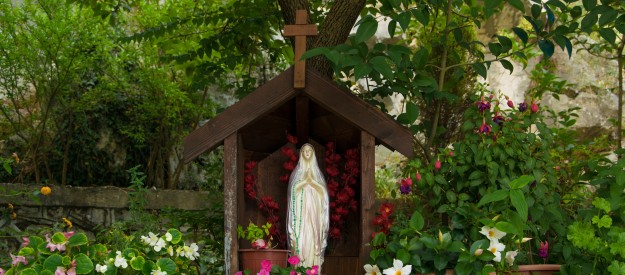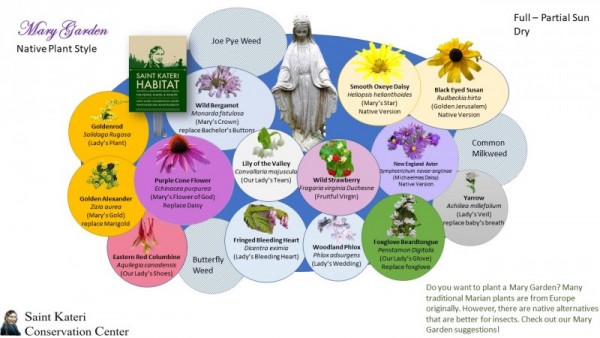"We are losing our attitude of wonder, of contemplation, of listening to creation and thus we no longer manage to interpret within it what Benedict XVI calls 'the rhythm of the love-story between God and man.'"
+ Pope Francis
Nurturing healthy ecosystems with Mary Gardens

We depend on healthy ecosystems for our survival. This includes clean air, clean water, and ecosystems that can adapt to a changing climate. We know that the more biodiverse an ecosystem, the better it's able to provide these "ecosystem services." However, biodiversity is decreasing on our planet.
When speaking of biodiversity in Laudato Si’, Pope Francis said “[t]he loss of forests and woodlands entails the loss of species which may constitute extremely important resources in the future, not only for food but also for curing disease and other uses. Different species contain genes which could be key resources in years ahead for meeting human needs and regulating environmental problems.”
However, there is hope.
One of the best ways to help increase biodiversity is to reduce barren lawns and plant trees and plants on native to your area on your property, whether that be in your yard, on your Parish or school grounds, or even your apartment balcony. We need to integrate our developed communities with nature. Native plants provide food for pollinators and sequester carbon, as well as increase biodiversity.
Science has shown that integrating native plants on our properties on a large scale could restore ecosystems on the same scale as creating a national park. However, inspiring large numbers of people to make these changes at such a grand scale seems like a daunting task.
Fortunately, the Church does not lack in number.
Did you know that there are over 70 million Catholics living in the US, not to mention the numerous parishes and religious orders that own large swaths of land? Imagine if just a fraction of Catholics changed the way they manage their properties, and planted native plants and trees? Together, we could restore the planet!
A year ago, the Saint Kateri Conservation Center developed its Saint Kateri Habitat Program, a program designed to inspire people of faith to increase biodiversity on their properties through creating and designating a Saint Kateri Habitat. One example of a type of Saint Kateri Habitat is a Mary Garden. Creating a Mary Garden has been an activity dating back hundreds of years, originally in Europe. Many plants have legends and symbols associated with them that represent Mary, or some aspect of scripture.
From Mary’s crown visible in many Marian apparitions, to her veil, her gloves, and even her bleeding heart, the possibilities of plants that represent Mary and our Lord are endless.
However, because Mary Gardens originated in Europe, the plants that are described are native to that region, and not in the United States. While some non-native plants do provide food for pollinators, using plants that are native to the United States in a Mary Garden can be both spiritually fulfilling and ecologically beneficial for our Earth and the creatures who dwell in it.
Thankfully, many of the traditional Mary Garden plants have native alternatives to help preserve biodiversity!
The Saint Kateri Conservation Center has begun a project to identify native alternatives to traditional Mary Garden plants. Some of the native plants were chosen because they look similar to the traditional versions. However, some of these plants have the same genus as their European relatives! To read more and explore the species, visit the Center’s Mary Garden page.
Below you will find a diagram of a Mary Garden using native plants native to the East Coast of the USA. Click here to download it.

This Mary Garden includes species native to the east coast of the USA, in a site with full to partial sun, that is slightly moist to dry most of the time. You will see the common name of the plant, the symbolic meaning, and the European plant it is replacing. You will also see three plants with no meaning. These are there to show that you can also add other important native alternatives to the garden along with the symbolic plants. Below the diagram, you can see a table of the plants and a link to each to learn more. Native plants are often not sold at your normal department stores!
To purchase native plants, you must either visit a native plant nursery or purchase plants online. The Center has created a Native Plant Nursery Map to help you find your closest nursery! This is the best option because local ecotype plants are best. But, if you would like to order online, you can visit Prairie Moon.
Please, don’t forget to register your garden as a Saint Kateri Habitat on the Saint Kateri Conservation Center Website! You can see all of the registered habitats on our Saint Kateri Habitat Tour Map!
Kat Hoenke is a volunteer for the Saint Kateri Conservation Center serving as the Program Director. She holds a Masters of Environmental Management and has a background in wildlife conservation.


















